The Desktop Kabini Review Part 1: AMD Athlon 5350 (AM1) Tested
by Ian Cutress on April 9, 2014 8:00 AM ESTCPU Benchmarks
Console Emulation – Dolphin Benchmark: link
At the start of 2014 I was emailed with a link to a new emulation benchmark based on the Dolphin Emulator. The issue with emulators tends to be two-fold: game licensing and raw CPU power required for the emulation. As a result, many emulators are often bound by single thread CPU performance, and general reports tended to suggest that Haswell provided a significant post to emulator performance. This benchmark runs a Wii program that raytraces a complex 3D scene inside the Dolphin Wii emulator. Performance on this benchmark is a good proxy of the speed of Dolphin CPU emulation, which is an intensive single core task using most aspects of a CPU. Results are given in minutes, where the Wii itself scores 17.53; meaning that anything above this is faster than an actual Wii for processing Wii code, albeit emulated.
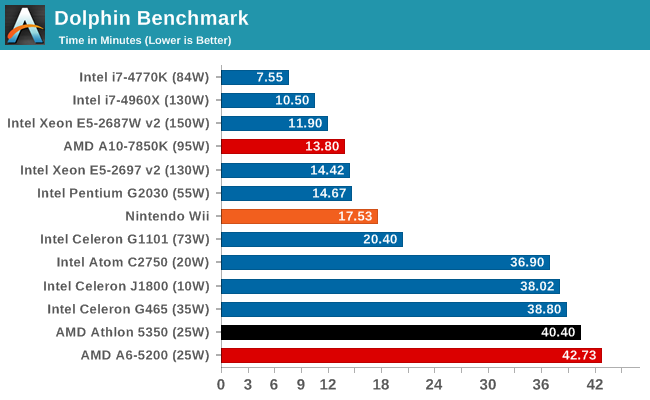
Point Calculations – 3D Movement Algorithm Test: link
3DPM is a self-penned benchmark, taking basic 3D movement algorithms used in Brownian Motion simulations and testing them for speed. High floating point performance, MHz and IPC wins in the single thread version, whereas the multithread version has to handle the threads and loves more cores.
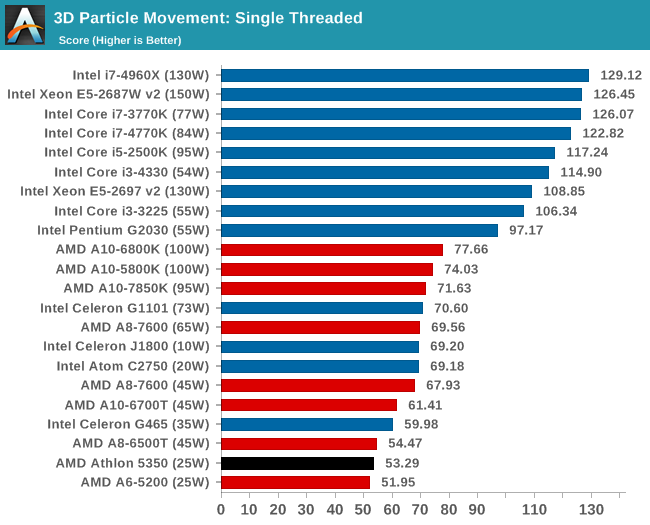
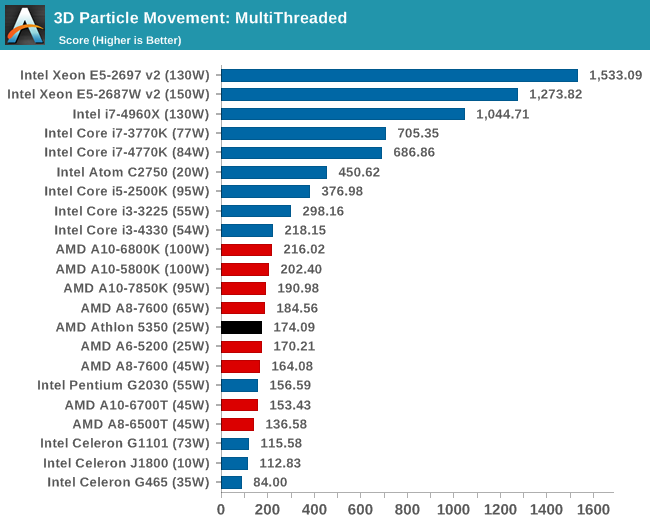
Encryption –TrueCrypt v0.7.1a: link
TrueCrypt is an off the shelf open source encryption tool for files and folders. For our test we run the benchmark mode using a 1GB buffer and take the mean result from AES encryption.
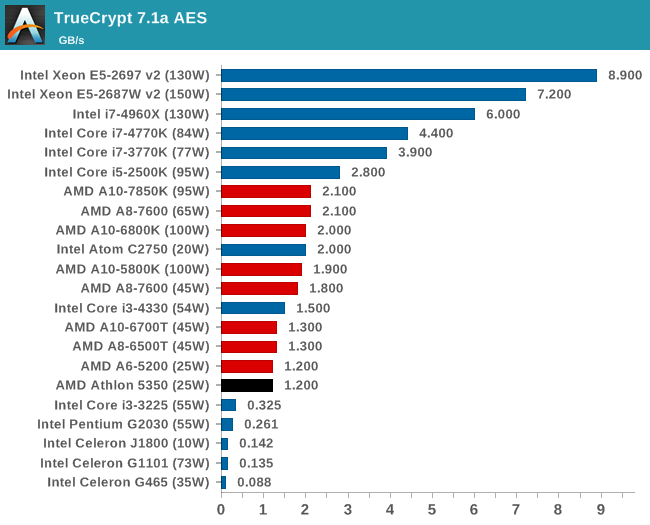
Synthetic – 7-Zip 9.2: link
As an open source compression tool, 7-Zip is a popular tool for making sets of files easier to handle and transfer. The software offers up its own benchmark, to which we report the result.
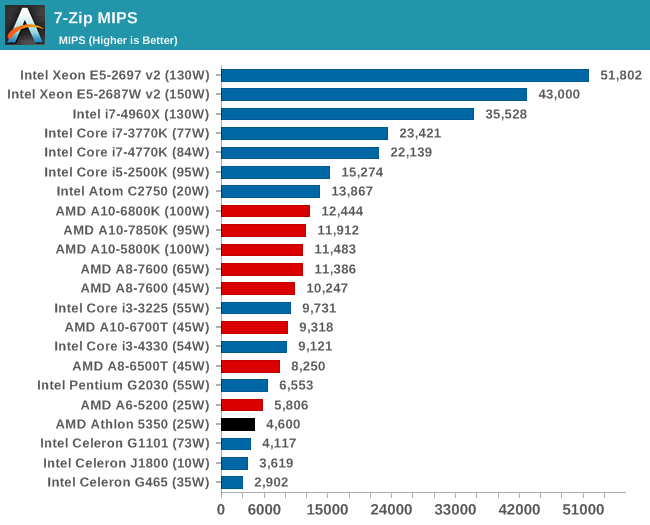
Rendering – PovRay 3.7: link
The Persistence of Vision RayTracer, or PovRay, is a freeware package for as the name suggests, ray tracing. It is a pure renderer, rather than modeling software, but the latest beta version contains a handy benchmark for stressing all processing threads on a platform. We have been using this test in motherboard reviews to test memory stability at various CPU speeds to good effect – if it passes the test, the IMC in the CPU is stable for a given CPU speed. As a CPU test, it runs for approximately 2-3 minutes on high end platforms.
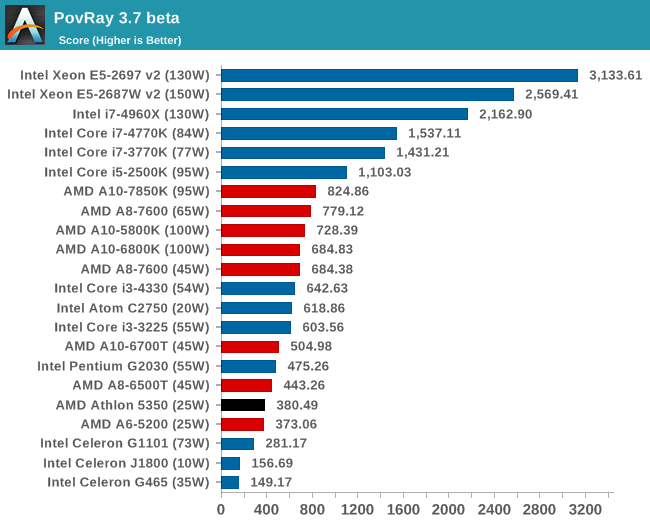










126 Comments
View All Comments
meacupla - Wednesday, April 9, 2014 - link
oh, god... semiporn is back...ViRGE - Wednesday, April 9, 2014 - link
There's a Duron joke in here somewhere...Death666Angel - Wednesday, April 9, 2014 - link
The good old days for AMD. That's when I got into PC stuff. Good times.nathanddrews - Wednesday, April 9, 2014 - link
Please tell me you are going to pair Kabini with 295x2. LOLscottjames_12 - Wednesday, April 9, 2014 - link
That WOULD be interesting! See how starved the monster GPU gets with an anemic CPU..nathanddrews - Wednesday, April 9, 2014 - link
I know that people are always trying to pair appropriate CPUs and GPUs together to avoid bottlenecks, but the honest truth is that a lot of people just leapfrog their builds every few years alternating between CPU and GPU upgrades. I don't know many people that buy/build a completely new system every 2 or 5 years. I know it happens plenty, but I know a lot of people running Conroe-era CPUs with modern GPUs. Up until a year ago, I was running an old GTX 470 on my 3570K. If money were no object, I would constantly be upgrading, but for now I wait until I absolutely need to.I'm probably just weird, but I spent a couple *hours* over the weekend watching YouTube videos of old PCI or AGP-based Pentium and Athlon systems playing modern games and modern OSs. Some are terrible while others are actually playable. Pushing old or slow hardware beyond the reasonable limits to see just what you can get away with is a fun pastime of mine.
NeatOman - Wednesday, April 9, 2014 - link
I always tell people to go a little overkill on the CPU in case later on they upgrade the GPU.. mostly because they wont be gaming on it most the time and i think its money better spent and later it won't give you much of a CPU bottleneck. Also because if you got a i7 from 6 years ago (yeah, they came out in 2008).. it would only be about 15%-20% slower. But a GPU that was $300 6 years ago lol, yeah right... a HD 3850 from around 6 years ago is about 1/3 the speed of a HD 7850 and twice the price. So over time a CPU holds it value and GPU can drop from year to year by up to half (for the high end models).I've found that spending more then $250 ($200 being the sweet spot) is a point of diminishing returns, and same goes for CPU's.
fokka - Wednesday, April 9, 2014 - link
i'd still go with a fast i5 instead of i7, except i've really got money to burn. i5 is where you get the best bang for your buck at intel, with a level of performance sufficient for the following years. paying 50% more for 10-20% increased performance doesn't seem very effective to me. this might have been a bit different with the first core-i CPUs.you're right about the GPUs though.
jonathanharrison - Thursday, April 10, 2014 - link
I wish they made more P-series chips, like the i5-3350P, that has the graphics core disabled, for gamers who are just going to get a discrete card(s) anyway. An i3-4370P (you could speed bump the core to 3.8, maybe 4.0GHz since you would be disabling the graphics core) would be nice. So would an i5-3570PK :) But that would just be tantamount to intel admitting failure at delivering 3D performance. Oh, this is an AMD article? Heh, I almost forgot with everyone talking about intel.tecknurd - Wednesday, April 9, 2014 - link
You may think that going "a little overkill on the CPU" may be a good suggestion, but it is not. I found over the years that it is better to spend on the storage system and memory. Back in 2012, I went with a i3-3225. I could go with an i5-3570 processor. That i5 processor will be a little overkill of what I do. The cost of that i5 processor just gives me a lot of grunt that I will rarely will use. That i5 processor will cut in my budget, so I can not go with a good storage system and/or go with a decent size of memory. If I add a graphics card, the med-end graphics models would not be bottleneck by my processor. If I go with a high-end graphics models, then yes the processor that I picked will bottleneck the high-end graphics card.A CPU only holds value if it is overclockable and the motherboard supports overclocking the processor. The storage system holds more value than any hardware in your computer because the reason why people went from hard drives to solid-state drives. A graphics card has no value since the technology of graphics changes dramatically. Also high quality or details of graphics during game play does not matter.